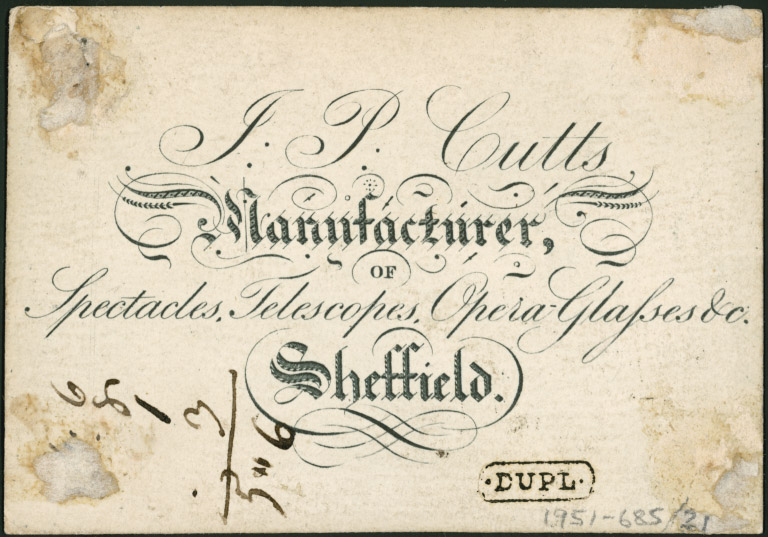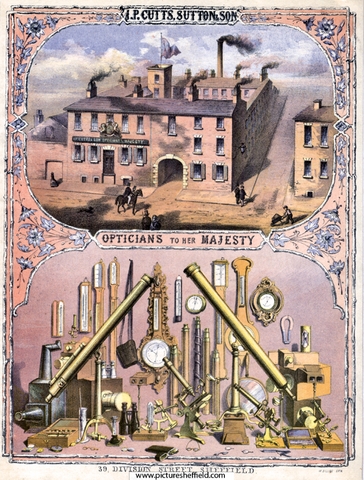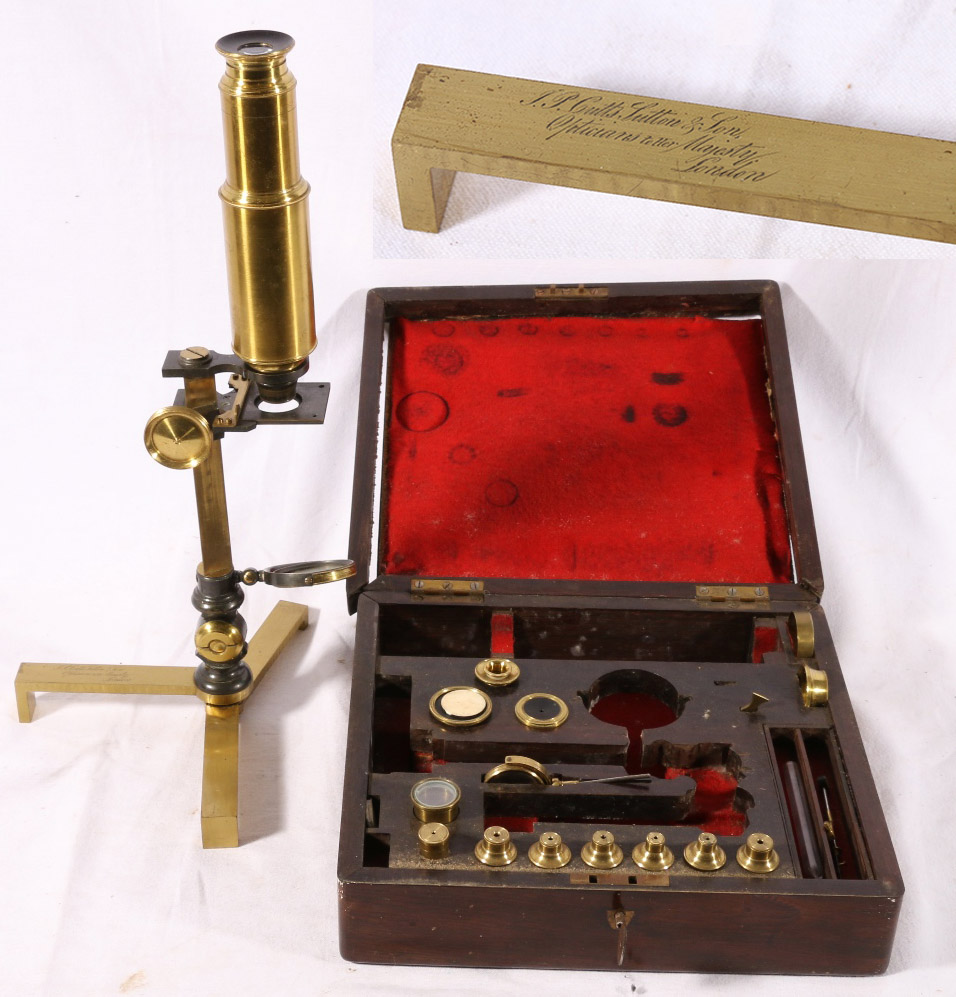
Figure 1. A trade card of John Priston Cutts. It does not mention his royal appointment, and so presumably pre-dates the card shown in Figure 2.
John Priston Cutts, 1787 - 1858
William Waterhouse Cutts, 1814 - 1871
Henry Gilbert Cutts, 1818 - 1866
John Sutton, ca.1788 - 1859
James Sutton, 1822 - 1894
owners of:
by Brian Stevenson
last updated April, 2019
Under a variety of ownerships and names, this series of businesses manufactured microscopes, other optical apparatus, razors, nautical equipment, and other devices. They were headquartered in Sheffield, England, and at times operated branches in London and New York City.
J.P. Cutts’ middle name is variously spelled “Priston” and “Preston” in contemporary and modern records. It is invariably spelled “Priston” in government records of voter registrations and the probate of his will, so I will follow those authorities.
He was born February 19, 1787, in Leeds. He apprenticed as a optical craftsman with the Sheffield company of Proctor and Beilby. Later advertisements from successor companies stated that Cutts began his business in 1804. He would then have been about 17 years old, so 1804 could have been either the year Cutts began or ended his apprenticeship.
His earliest known business address is 58 Norfolk Street, Sheffield, recorded in an 1822 city directory. Around 1828, he moved the business to Division Street, Sheffield, and it remained there until his death. In addition to optical instruments, Cutts manufactured metal implements such as razors, knives, powder flasks, and liquor flasks (Figure 7).
Cutts opened a branch shop / warehouse in London, probably about 1836. That year he entered a trademark as a spectacle case manufacturer, with address 3 Crane Court, Fleet Street. An 1834 advertisement did not list a London address (Figure 7). That venture appears to have been very short-lived, as an 1839 advertisement stated “Late warehouse in London, removed to Sheffield” (Figure 8).
During the 1830s, Cutts became associated with James Chesterman (1792-1867). Chesterman invented a number of devices, including the spring tape measure and a self-winding window blind (Figures 7 and 8). An 1837 directory of Sheffield listed “Cutts John Preston, optical, mathl. & philosl. instrument mfr. & sole mfr. of Chesterman's patent self acting window blind & map rollers, tape measures, &c. Division st.”, and “Chesterman Jas. patentee and mfr. of the newly invented spring tape measures, spring map and window blind rollers, and spring hinges & door closers; at I.P. Cutts', Division st.” The formal partnership of Cutts, Chesterman & Co. was in existence by 1855, when they exhibited “measuring tapes”, at that year’s Paris Exposition. Another partner, James Bedington (ca. 1811-1890), later joined to form Cutts, Chesterman, & Bedington. That company dissolved in 1859, after Cutts’ death. Chesterman took over the former business, and remained in Sheffield for many decades. Bedington moved to Birmingham, where an 1858 directory listed him as “mfr. of pocket & ship compasses, mathematical instruments, English and foreign measuring tapes, box and ivory rules, perspective and ship telescopes, quadrants sextants, patent log and time glasses, and sole mfr. of Webster's patent mercury steam vacuum water gauges, 10 Russell st; h, Balsall heath”.

Figure 1.
A trade card of John Priston Cutts. It does not mention his royal appointment, and so presumably pre-dates the card shown in Figure 2.

Figure 2.
A later trade card, advertising Cutts’ appointment as “Optician to the Queen”. Victoria came to the throne in 1837. Adapted for nonprofit, educational purposes from http://www.sciencemuseum.org.uk/online_science/explore_our_collections/objects/index/smxg-8002185

Figure 3.
J.P. Cutts case-mounted ("Cary-Gould") microscope. His address is given as “London”, dating it to before ca. 1840. An advertisement published in that year stated that Cutts recently closed his London warehouse (see Figure 8). Adapted for nonprofit, educational purposes from an internet auction site.

Figure 4.
A telescope, signed “J.P. Cutts London”, dating it to before ca. 1840. Adapted for nonprofit, educational purposes from an internet auction site.

Figure 5.
A compound microscope, signed “J.P. Cutts Optician to Her Majesty Sheffield”, dating it to between 1837 and 1840. It is a modernized adaptation of the Jones Most Improved form, similar to a style developed by Philip Carpenter ca. 1830. The spring-loaded stage moves by rack-and-pinion on a triangular stem.

Figure 6.
A linen proofer, signed “J.P. Cutts Optician to Her Majesty Sheffield”,. Adapted, with permission, from http://www.microscope-antiques.com.

Figure 7.
An 1834 advertisement. Adapted for nonprofit, educational purposes from http://www.gracesguide.co.uk/I._P._Cutts.

Figure 8.
An 1839 advertisement, Adapted for nonprofit, educational purposes from http://www.gracesguide.co.uk/I._P._Cutts.
Two of J.P. Cutts’ sons, William and Henry, joined him in business to form J.P. Cutts & Sons. Since the 1839 advertisement shown in Figure 7 lists only Cutts, the firm presumably started sometime in the early 1840s, when the sons would have been in their early 20s.
Within a few years, possibly in 1845, John Sutton joined the optical side of the Cutts’ business, forming J.P. Cutts, Sons and Sutton. A separate general mercantile business persisted as J.P. Cutts & Sons. Sutton had previously operated a stationer’s shop and lending library. A telescope is known with the signature “J.P. Cutts, Sons and Sutton” and carrying addresses of Sheffield and London (Figure 13), indicating that company re-opened in London during the mid-1840s.
Those two businesses reorganized in 1849, without the two Cutts sons:
The optical business: “Notice is hereby given, that the Partnership heretofore subsisting between John Preston Cutts, William Waterhouse Cutts, Henry Gilbert Cutts, and John Sutton, carrying on the business of Opticians, in Sheffield, in the county of York, under the firm of J.P. Cutts, Sons, and Sutton, was, on the 1st day of May instant, dissolved by mutual consent; and that the said business will in future be carried on by the said John Preston Cutts and John Sutton, under the said style or firm of J.P. Cutts, Sons, and Sutton, by whom all debts owing by or to the said partnership will be paid and received. - Witness our hands this 15th day of May 1849. J. P. Cutts. William W. Cutts. Henry Gilbert Cutts, by his Attorney, Richd. T. Taylor. Jno. Sutton”.
The mercantile business: “Notice is hereby given, that the Partnership heretofore subsisting between John Preston Cutts, William Waterhouse Cutts, and Henry Gilbert Cutts, carrying on the business of General Merchants, in Sheffield, in the county of York, under the firm of J.P. Cutts and Sons, was, on the 1st day of March last, dissolved by mutual consent; and that the said business will in future be carried on by the said John Preston Cutts, by whom all debts owing by or to the said partnership will be paid and received. - Witness our hands this 15th day of May 1849. J.P. Cutts. William W. Cutts. Henry Gilbert Cutts, by his Attorney, Richd. T. Taylor”.
Henry Cutts moved to Buenos Aires, Argentina, apparently operating an import/export business between there and London. He may have already left by 1849, necessitating his use of an attorney for the final signatures. Henry filed for bankruptcy protection in London in 1860, and died in Argentina in 1866. William Cutts operated a separate business in Sheffield for several years, and moved to London before 1861. He formed a hardware business with one Arthur Linley, as Linley, Cutts and Co., operating in both London and Sheffield. That business dissolved in 1865, and William died in 1871.
The partnership between Cutts and Chesterman continued separately for another ten years.
By 1852, John Sutton’s son, James, had joined the firm, and the name changed to J.P. Cutts, Sutton, & Son (Figure 14). The 1854 Post Office Directory of Sheffield included “Cutts J.P. Sutton & Son, opticians to her Majesty, 39 Division street, Sheffield, & 56 Hatton garden, London, & 248 Pearl street, New York”, and “Cutts, Chesterman & Co. manufacturers of patent metallic & steel tape measures, blind springs, door hinges, routing jacks, ratchet & other drilling machines, & general machinists, 39 Division road”.
John Priston Cutts died on September 8, 1858, at his Sheffield home. John Sutton died half a year later, on April 26, 1859.
The optical business reorganized in 1860 under the sole ownership of James Sutton. He was a skilled optician, presumably having apprenticed with Cutts. James retained the business name J.P. Cutts, Sutton, & Son, presumably because of Cutts’ reputation.
J.P. Cutts evidently bequeathed a substantial portion of his businesses’ stock to his heirs. Sutton either could not afford or did not want to buy those goods. In March, 1862, the auction house of J.C. Stevens, London sold “a Portion of the Stock of the late Mr. J.P. Cutts, Manufacturing optician of Sheffield, comprising the Finished and Unfinished stock, consisting of a Large Quantity of Expensive Telescopes - Opera Glasses - Spectacles - Microscopes - Eye-Glasses - Lenses - Mathematical Instruments - Photographic Apparatus, &c.”.
The J.P. Cutts, Sutton, & Son business was a large, successful operation at that time. The 1861 census lists James Sutton as “Optical Instrument Manufacturer Master employing 25 men, 6 boys, 19 women & girls”.
Sutton exhibited at the 1862 London International Exhibition, “some admirable and instructively-arranged specimens of glass for optical purposes are deposited in the gallery by Cutts, Sutton and Son, opticians to her Majesty, 43, Division street, Sheffield. These consist of coloured and white crown glass, plate glass, achromatic flint glass, crown and flint discs used in the construction of the best quality of achromatic object glasses for telescopes, &c. In fact, glasses and pebbles of every quality and kind used in the construction of optical instruments, and in their various stages of progress, from the rough to the finished lenses, are here to be seen, and from them a good idea may be formed of the amount of labour exerted in bringing them to the proportion in which they are found in well-made microscopes and telescopes”.
An 1864 directory listed, “Cutts, J.P., Sutton & Son, 34 Division-st. To Her Majesty. Manufacturers and exporters of all kinds of telescopes for ships, portable or astronomical purposes, object glasses and eye lenses for ditto, opera, race, and marine glasses, sling cases for telescopes and marine and race glasses”, and “Shooting Tackle Makers. Cutts, J.P. Son & Co., 34 Division-st. Also gun-case makers; breechloading cartridge carriers; game bags of all sizes, descriptions and qualities”.
For a few years, in the mid-1860s, James brought his brother, John, into the business. For that brief time, the business became J.P. Cutts, Sutton, & Sons. The partnership dissolved in November, 1867, with only James remaining. The business was then, for the second time, named J.P. Cutts, Sutton, & Son.
An advertisement published in 1876 indicated that the name had changed, again, to J.P. Cutts, Sutton, & Sons. The time, the plural “Sons” was probably due to James’ eldest son, Henry, joining the firm. The 1881 census listed the factory as employing 14 men, 3 boys, and 5 girls.
The business remained J.P. Cutts, Sutton, & Sons until it was dissolved in 1887. There are no indications that any further business was conducted afterward under the names of either Cutts or Sutton.
James Sutton died at home, in early 1894.

Figure 9.
A “Martin drum”-style microscope, signed “J.P. Cutts & Sons Sheffield”. That signature dates this instrument to ca. early 1840s. Adapted for nonprofit, educational purposes from an internet auction site.

Figure 10.
Top part of a Cuff-style microscope, engraved “J.P. Cutts & Sons, opticians to Her Majesty”. Originally, the body would have been mounted on a square wooden base. Cuff developed this pattern in the mid 1700s, and probably would have been considered obsolete by most people, when the Cutts made this in the early 1840s. Adapted for nonprofit, educational purposes from an internet auction site.

Figure 11.
J.P. Cutts & Sons telescope, ca. early 1840s. Adapted for nonprofit, educational purposes from an internet auction site.

Figure 12.
Case for a straight razor, marked “J.P. Cutts & Sons, Division Street, Sheffield” telescope, ca. early 1840s. Adapted for nonprofit, educational purposes from http://straightrazorplace.com/razors/104750-were-wooden-leather-covered-boxes-used-sr-coffins-help.html.

Figure 13.
A case-mounted "Gould/Cary"-type microscope. The upright is signed "J.P. Cutts, Son & Sutton, Opticians to Her Majesty, Sheffield", dating its manufacture to between ca. 1845 and ca. 1850. Adapted for nonprofit, educational purposes from an internet auction site.

Figure 14.
Two telescopes, both signed “J.P. Cutts, Sons & Sutton”. The left telescope is addressed from Sheffield, while the other carries the addresses Sheffield and London. Adapted for nonprofit, educational purposes from internet auction sites.

Figure 15.
An 1852 advertisement for J.P. Cutts, Sutton & Son. Evidently, James Sutton had joined the partnership by this time. Adapted for nonprofit, educational purposes from http://www.gracesguide.co.uk/I._P._Cutts_Sutton_and_Sons.

Figure 16.
An undated trade card of J.P. Cutts, Sutton & Son. The upper picture indicates that they had a sizeable factory. The lower picture illustrates some of the items manufactured by J.P. Cutts, Sutton & Son, including microscopes, telescopes, eye glasses, binoculars, magic lanterns, steroscopes, barometers, thermometers, and hour glasses. Those products, which all contain finely-wrought glass, were usual products of 19th century "opticians". Adapted for nonprofit, educational purposes from an unattributed Google Image.

Figure 17.
A drum microscope, signed "J.P. Cutts, Sutton, & Son, Opticians to Her Majesty, Sheffield and London". Adapted for nonprofit, educational purposes from an internet auction site.

Figure 18.
One of the tripod feet is signed "J.P. Cutts, Sutton, & Son, Opticians to Her Majesty, Sheffield and London", dating this microscope to after 1850. This was an old style by then, being a modification of the 1830s "Carpenter's Improved" pattern. It is very similar to the earlier "J.P. Cutts"-signed microscope that is shown in Figure 5. Adapted for nonprofit, educational purposes from an internet auction site.

Figure 19.
A bar-limb / “Society of Arts”-pattern microscope, by J.P. Cutts, Sutton, & Son, Sheffield and London. Adapted for nonprofit, educational purposes from an internet auction site.

Figure 20.
A compendium magnifier, bearing the anchor and “Try Me” trademark of J.P. Cutts, Sutton, & Son(s). Adapted for nonprofit, educational purposes from http://www.lecompendium.com/dossier_optique_160_microscope_a_bille/microscope_a_bille.htm.

Figure 21.
A J.P. Cutts, Sutton, & Son sextant, with addresses of Sheffield and London. Adapted for nonprofit, educational purposes from an internet auction site.

Figure 22.
A compass by J.P. Cutts, Sutton, & Son. Adapted for nonprofit, educational purposes from an internet auction site.

Figure 23.
1857 advertisement, from T. Sutton’s 1857 “A Treatise on the Positive Collodion Process”.

Figure 24.
Entry for the 1870 ‘The Handbook to the Manufacturers and Exporters of Great Britain’, noting the anchor and “Try Me” trademark.

Figure 25.
Advertisement from 1876. Adapted for nonprofit, educational purposes from http://www.gracesguide.co.uk/I._P._Cutts_Sutton_and_Sons.

Figure 26.
Advertisement from 1882. Adapted for nonprofit, educational purposes from http://www.gracesguide.co.uk/I._P._Cutts_Sutton_and_Sons.
Resources
The Athenaeum (1862) Auction of J.P. Cutts’ property, pages 279 and 315
Balasse, Albert (accessed January, 2016) Le Compendium http://www.lecompendium.com/dossier_optique_160_microscope_a_bille/microscope_a_bille.htm
The Birmingham and District and Sheffield and Rotherham Commercial List (1865) Dissolution of Linley, Cutts and Co., Appendix, page 11
The Birmingham and District and Sheffield and Rotherham Commercial List (1867) Dissolution of J.P. Cutts, Sutton, & Sons, page 50
British Trade Journal and Export World (1882) “Optical, Mathematical & Philosophical Instrument Manufacturers. J.P. Cutts Sutton & Sons, Sheffield”, and “Dolphin Ship Logs. J.P. Cutts Sutton & Sons, Sheffield”, Vol. 20, pages 44 and 47
Cutts family tree (accessed January, 2016) http://person.ancestry.co.uk/tree/55580640/person/13841133446/facts
England census, voter, birth, marriage, and death records, accessed through ancestry.co.uk
General and Commercial Directory of the Borough of Birmingham (1859) W.H. Dix & Co., Birmingham, page 60
The Goldsmiths', Jewellers', Silversmiths', Watchmakers', Opticians', and Cutlers’ Directory (1863) “Linley, Cutts & Co., 233 Gresham-house”, page 71
Grace’s Guide (accessed January, 2016) http://www.gracesguide.co.uk/I._P._Cutts and http://www.gracesguide.co.uk/I._P._Cutts_Sutton_and_Sons
History, Directory & Gazetteer, of the County of York (1822) “Cutts T. P. manufacturer of telescopes, microscopes, spectacles, &c. 58, Norfolk street”, page 313
History, Gazetteer, and Directory, of the West-Riding of Yorkshire (1837) W. White, Sheffield, pages 112, 116, 171, 225, and 228
Law Journal (1887) Bankruptcy of J.P. Cutts, Sutton, & Sons, page 370
Leader, Robert E. (1876) Reminiscences of Old Sheffield: Its Streets and Its People, Second edition, pages 94-97
London Gazette (1849) Dissolution of J.P. Cutts, Sons, & Sutton, and of J.P. Cutts & Sons, page 1662
London Gazette (1859) Dissolution of Cutts, Chesterman & Bedington, page 3623
London Gazette (1860) Dissolution of J.P. Cutts, Sutton, & Son, page 2799
Mechanics Magazine (1862) On the London Exhibition, page 217
Nuttall, R.H. (1979) Microscopes from the Frank Collection, 1800 ~ 1860, A. Frank, Jersey, Channel Islands, page 48 and Figure 41. Nuttall cites Goodman, 1977, English Barometers 1680-1860, that, “the partnership between Cutts and Sutton was formed in 1845”
Paris Universal Exposition Catalogue (1855) page 22
Pigot and Co.’s National Commercial Directory (1837) pages 139, 141, 142, and 145
Post Office Directory of Sheffield (1854) pages 94, 157, 172, 175, 196
Probate of John Priston Cutts (1859) accessed through ancestry.co.uk
Probate of John Sutton (1859) accessed through ancestry.co.uk
ScienceMuseum.org (accessed January, 2016) http://www.sciencemuseum.org.uk/online_science/explore_our_collections/objects/index/smxg-8002185
Sheffield History - Sheffield Memories (accessed January, 2016) http://www.sheffieldhistory.co.uk/forums/index.php?/topic/3456-j-chestermans39-bow-works/
Sheffield Indexers (accessed January, 2016) http://sheffieldindexers.com/TradeDirectories.php?year=&directory=&forename=&surname=Cutts&occupation=&address=¤t_page=8
Slater’s National Commercial Directory (1846) page 19
The Spectator (1860) Bankruptcy of Henry G. Cutts, page 168
Straight Razor Place (accessed January, 2016) http://straightrazorplace.com/razors/104750-were-wooden-leather-covered-boxes-used-sr-coffins-help.html
Sutton, Thomas (1857) A Treatise on the Positive Collodion Process, Bland & Long, London, advertisement from J.P. Cutts, Sutton, & Son at rear of the book
William’s Manufacturers’ Directory (1864) pages 38, 595, 598, 604, and 609
Wright, George T. (1870) Handbook to the Manufacturers & Exporters of Great Britain, Wright & Co., London, page 348